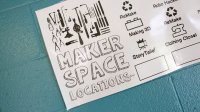Pop Up and Make: Student-Designed and Facilitated Makerspaces
See how introducing fluid, diverse makerspaces throughout a school can engage students in playing, collaborating, learning, and finding their passions.
Your content has been saved!
Go to My Saved Content.Let's set the scene with a school snapshot:
- Number of Students: 1,439
- Per Pupil Expenditure: $9,500
- White: 36%
- African American: 55%
- Hispanic: 6%
- Free and Reduced Lunch: 50%
- Makerspace Funding Sources to Date:
- LRNG Challenge: $20,000 ($6,000 for materials and supplies + $12,000 for teacher PD stipends)
- Academic Booster Grants ($5,000 for materials and supplies)
- Lowe's School Grants ($5,000 materials and supplies)
Makerspaces: Low- and High-Tech
Now let's ask: What might school look like with no bells, no walls, and no limits on learning? The Educator Innovator collaborative posed this question to educators across the country in 2014, spurring the design of interest-driven and production-centered learning opportunities to deepen students' passions.
In response, teachers and students from the above-mentioned school, J.H. Rose (JHR) High School in Greenville, North Carolina, in conjunction with the Tar River Writing Project at East Carolina University, received funds to design and implement pop-up makerspaces during the 2015-16 school year. These makerspaces include the 3D Fabrication Lab, Upcycling Shop, Music and Beat-Making Studio, Robotics and Hacking Space, Digital Storytelling Workshop, and Clothing and Fashion Design Closet. Each makerspace "pops up" in either a classroom, computer lab, commons area, or the cafeteria during the school's Smart Block, an open period for eating lunch, attending academic sessions, practicing sports and music -- and now for making things. With high- and low-tech materials, with digital and analogue tools, each space offers leveling-up curriculum pathways that are meant to scaffold tinkering, playing, experimenting, making, and learning.
In the Remake Lab, students and teachers upcycle furniture, old tires, and other discarded materials, transforming old dresser drawers into pet beds and selling them to raise more funds for supplies. A student works on a lamp project, combining an old basket with a donated light assembly to make a place for studying in her living room. Another student tears sheets from a wallpaper sample book and glues them to a barstool, contributing to a decoupage project that multiple students have worked on all semester -- a low-barrier project that almost any student could "Pop Up and Make." "In here," the student says, "it's mandatory to make something. It doesn't matter what, but you have to get jiggy."
In the RoboHacker Lab, students mix and match littleBits circuits, troubleshooting with teachers and Maker Mentors when lights don't light up or fans don't spin. Howls of laughter echo in the hallway as students race neon-colored Spheros, ribbing losers while helping them optimize for closer races. A student is learning to code in Python to make formulas for his math homework while his friend, a Maker Mentor, builds a car from Lego Robotics.
In the 3D Lab, students browse light saber designs in Thingiverse, set up new portable Micro 3D printers, draw with 3D pens, and fold Cubecraft cartoon figures. Maker Mentors and teachers help students reload spools of filament, scale digital objects on the computer, reinforce X-acto knife safety rules, and greet new students at the door. "When the makerspace first started," reports one student, "I became well acquainted with the 3D pen, coming every Monday and Friday to work on an Eiffel Tower -- I love its architecture and design. Eventually, I started working with the 3D printers. There's always something new and interesting to make and learn."
Participatory Design
The popularity of this Pop Up and Make educational model is due, in part, to its participatory design. To begin, faculty surveyed the students about their interests, asking, "What do we make together that will make school responsive to your needs?" After reviewing survey results, faculty read and discussed case studies of maker-centered learning, thinking through local affordances and constraints. In summer, they convened at East Carolina University's campus, making together in a pop-up fabric hacker lab and planning their makerspaces. Here they developed open curriculum materials, budgeted for tools and supplies, and recruited student leaders. Fifteen students joined the event to make, co-develop, plan, and become Maker Mentors. School leadership also attended, offering support such as reassigned time, access to space, and other assets. During the back-to-school orientation, Maker Mentors staffed the spaces, demonstrated making, distributed information and created a buzz of excitement for the new year.
Space to Learn, Play, Make, and Grow
After a year, it's clear that makerspaces are making things happen at JHR. Students like Austin in the video above are developing their passions and technical capacities --taking pride in exciting others through their roles as Maker Mentors. Students who haven't yet discovered their objects of excitement are forming new nodes -- people, places, tools, practices -- on their learning networks. One student reports, "I first came here to help my friend print some vinyl for a sign. I met kids who were drawing on tablets and printing phone cases. I had never seen that before, so I came back. Teachers helped me, and I want to take their classes to learn more." Finally, makerspaces are providing safe spaces for positive peer-to-peer social interaction. A student in the Remake Lab quipped, "Really, we just started coming down here to talk and eat lunch together without anybody bothering us, but then we saw we could eat, talk, and make new things with old stuff -- stuff that makes us happy."
Follow #RampantsMake on Twitter and Instagram, and check out the school’s website Rampants Make.
